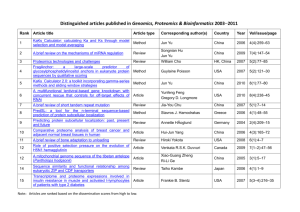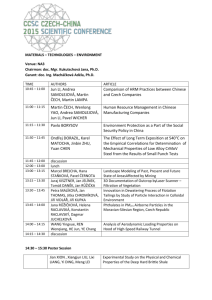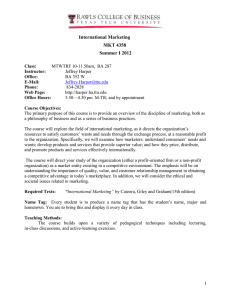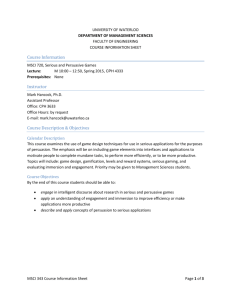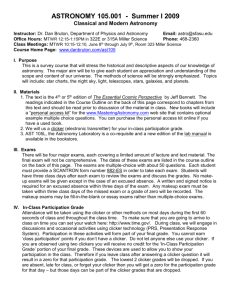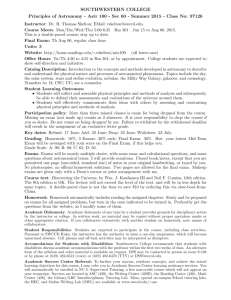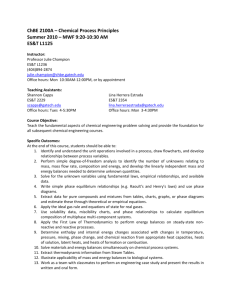Physics 220, Mechanics I
advertisement
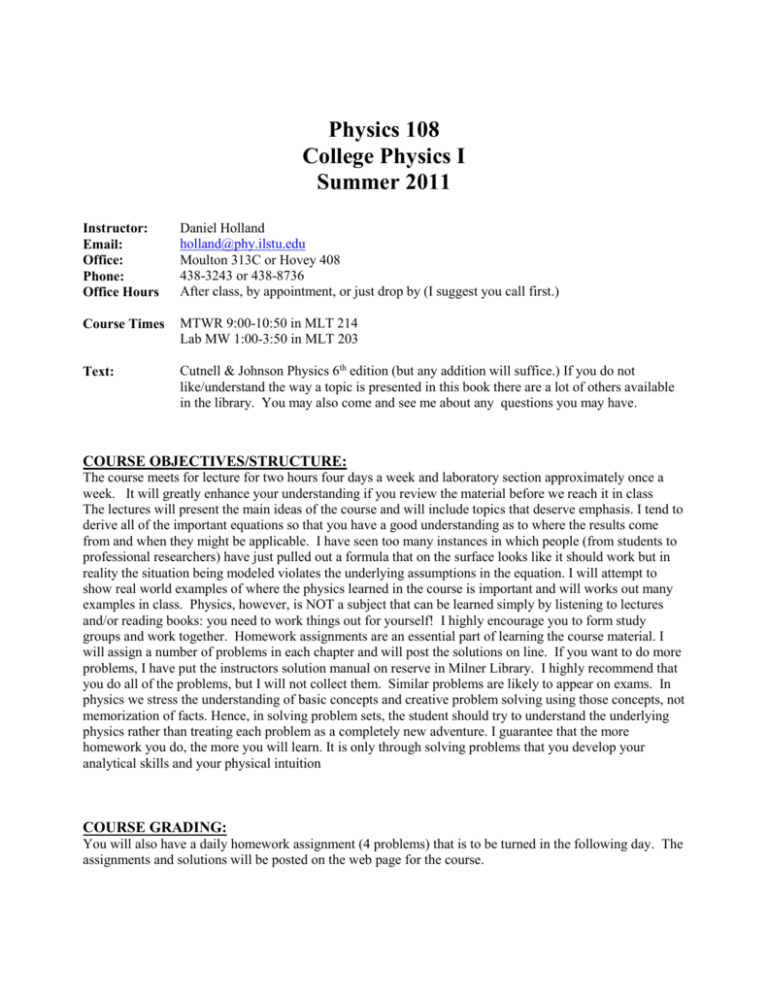
Physics 108 College Physics I Summer 2011 Instructor: Email: Office: Phone: Office Hours Daniel Holland holland@phy.ilstu.edu Moulton 313C or Hovey 408 438-3243 or 438-8736 After class, by appointment, or just drop by (I suggest you call first.) Course Times MTWR 9:00-10:50 in MLT 214 Lab MW 1:00-3:50 in MLT 203 Text: Cutnell & Johnson Physics 6th edition (but any addition will suffice.) If you do not like/understand the way a topic is presented in this book there are a lot of others available in the library. You may also come and see me about any questions you may have. COURSE OBJECTIVES/STRUCTURE: The course meets for lecture for two hours four days a week and laboratory section approximately once a week. It will greatly enhance your understanding if you review the material before we reach it in class The lectures will present the main ideas of the course and will include topics that deserve emphasis. I tend to derive all of the important equations so that you have a good understanding as to where the results come from and when they might be applicable. I have seen too many instances in which people (from students to professional researchers) have just pulled out a formula that on the surface looks like it should work but in reality the situation being modeled violates the underlying assumptions in the equation. I will attempt to show real world examples of where the physics learned in the course is important and will works out many examples in class. Physics, however, is NOT a subject that can be learned simply by listening to lectures and/or reading books: you need to work things out for yourself! I highly encourage you to form study groups and work together. Homework assignments are an essential part of learning the course material. I will assign a number of problems in each chapter and will post the solutions on line. If you want to do more problems, I have put the instructors solution manual on reserve in Milner Library. I highly recommend that you do all of the problems, but I will not collect them. Similar problems are likely to appear on exams. In physics we stress the understanding of basic concepts and creative problem solving using those concepts, not memorization of facts. Hence, in solving problem sets, the student should try to understand the underlying physics rather than treating each problem as a completely new adventure. I guarantee that the more homework you do, the more you will learn. It is only through solving problems that you develop your analytical skills and your physical intuition COURSE GRADING: You will also have a daily homework assignment (4 problems) that is to be turned in the following day. The assignments and solutions will be posted on the web page for the course. There will be four hour long exams (including the comprehensive final exam) and eight labs. A typical exam will test for both conceptual understanding and problem solving ability. This is the first time I have taught this course, so I do not have any practice exams available. You will be allowed to bring a calculator and a single 8 1/2 x 11 "cheat sheet" to exams. This sheet may have anything you want written on it. (I will not look at them or collect them.) Make-up exams will only be given in cases of excused absences due to illness, serious illness or death in your immediate family, or other significant reasons. If you know that there will be a problem, let me know ASAP so we can work something out. There will be eight labs. Laboratory reports will be graded on a 15 point scale. The first 5 points is based on attendance and the prelab sheet. The remaining 10 points are for the report itself. I will ask the UTA to take attendance each lab period. NO MAKE-UP LABS WILL BE GIVEN. (This is because the lab set ups are put away after the lab is done.) If you know in advance that you cannot attend your lab section, it is generally not a problem to go to another section. To account for possible absences, the lowest lab grade will be dropped. The final score will be determined from the following weights: Hour Exams (3) Labs Homework Final Exam Total 50% 15% 15% 20% 100% Letter grades are not assigned on an individual exam, but will be determined at the end of the course when all scores are in. There are no hard and fast letter grade boundaries (i.e. I do not grade on a strict percentage basis) nor is there a statistical formula used to determine grade boundaries (i.e. I do not grade on a curve). Instead, statistics are used as a guide to determine underlying standards. When needed, factors such as class participation, improvement, industriousness, etc. may be used in borderline cases. Statistics will be given on each exam so that you may estimate where you stand in relation to the rest of the class. TENTATIVE SYLLABUS Chapter(s) Lab May 16 – May 20 Dates 1,2,3 No Lab Topics May 23 – May 27 4,5 A1 (Mon) May 30 – Jun 03 6,7 Work and Energy, Impulse and Momentum Jun 06 –Jun 10 8,9 A2 (Mon) A3 (Wed) A4 (Mon) Jun 13- Jun 17 10,11 B1 (Mon) Simple Harmonic Motion, Fluids Jun 20 – Jun 24 12,13 B2 (Mon) Temperature and Heat, Heat Transfer Jun 27 – Jul 01 14,15 A7 (Mon) The Ideal Gas Law and Kinetic Theory, Thermodynamics Jul 04 – Jul 08 16,17 C1 (Mon) Waves and Sound, Linear Superposition and Interference Introduction, Mathematics review, Kinematics in one and two dimensions Forces and Newton’s Laws, Dynamics of uniform circular motion Rotational Kinematics and Dynamics Final Exam: Thursday, July 7, 2011 9:00 AM

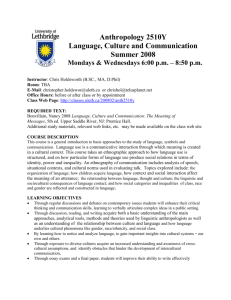

![[#DASH-191] Replace JERSEY REST implementation by](http://s3.studylib.net/store/data/005918124_1-33fb89a22bdf4f7dbd73c3e1307d9f50-300x300.png)

